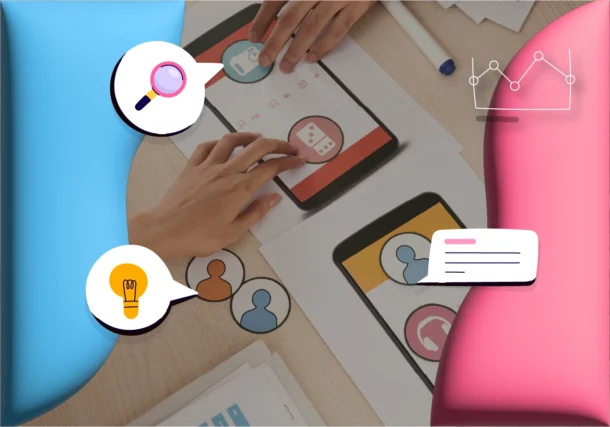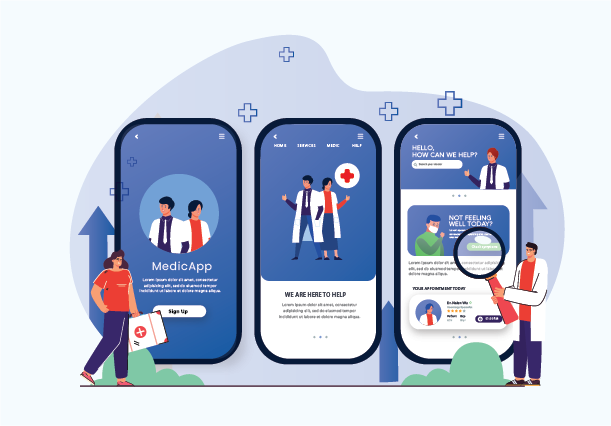A Digital Adventure: Routing the Realm of UX Interaction Design
Imagine a world of UX interaction design where, with each click, swipe, and scroll, great digital experiences can be crafted. Users embark on a journey filled with twists, turns, and amazing discoveries.  Visualize taking visitors through a well-thought-out labyrinth of digital levels whereby every encounter is crafted to move them smoothly to their final goal. The ultimate goal of UX interaction design is to create intuitive digital experiences that engage customers when they visit a website or use an application. Be it shopping online, booking a travel ticket, or streaming, all that users need is a simple, quick, and pleasant experience.
Visualize taking visitors through a well-thought-out labyrinth of digital levels whereby every encounter is crafted to move them smoothly to their final goal. The ultimate goal of UX interaction design is to create intuitive digital experiences that engage customers when they visit a website or use an application. Be it shopping online, booking a travel ticket, or streaming, all that users need is a simple, quick, and pleasant experience.
Every UI aspect plays a crucial role in defining such experiences, from the placing of buttons down to how information flows. Seamless digital journeys are paramount in today’s hyper-connected environment, when rival frames and attention spans are very short. Users give up too easily when they face difficulties or disappointments. It is therefore fundamental that designers expertly understand how UX interaction design works so as to be able to lead users down easy, natural routes to their objectives.
This blog is inspired-from developing strategies to finding the best practices that will help in creating frictionless digital experiences. It will act like your compass in this enormous and ever-growing field of UX design. Join us on a journey through the exciting field of UX interaction design, whether you’re a professional designer wanting to hone your craft or a beginner wanting to learn the basics.
Scouting the Depths of UX Interaction Design
Let’s plunge into the world of User Experience and Interaction Design as we begin this journey, where each pixel may have some story to say and  every click may open up possibilities of an exciting voyage. Like pixel painting, UX interaction design marries form and function in an effort to create experiences that delight people and put a smile on their faces. In other words, human needs and wants along with behaviors are interpreted into understandable and user-friendly interfaces. When we go deeper, we find that there are some basic concepts guiding good interaction design with UX in support, including visibility of affordance, feedback, and simplicity.
every click may open up possibilities of an exciting voyage. Like pixel painting, UX interaction design marries form and function in an effort to create experiences that delight people and put a smile on their faces. In other words, human needs and wants along with behaviors are interpreted into understandable and user-friendly interfaces. When we go deeper, we find that there are some basic concepts guiding good interaction design with UX in support, including visibility of affordance, feedback, and simplicity.
But, in any case, great design has the power to creep into people’s minds and take psychological concepts to its advantage in the favor of molding user behaviors. Everything-from color psychology to cognitive biases-involves psychology in great measure for the creation of user experiences and increasing engagement. Designers will be able to create interfaces that make a better connect by understanding the psychological factors that influence user decisions.
The interaction design in UX applies the principles of a user-centered design methodology that provides great emphasis on feedback provided by the users; thus, empathy naturally leads such a process. This means putting one’s self in the user’s shoes and learning about their problems in order to devise solutions based upon the needs of the end. In giving precedence to user needs and wants, a designer can thus construct experiences tailored for each user. Buckle down for an unforgettable journey into the world of UX interface design; grab your virtual knapsack. It’s time to find out how amazing design creates magic in digital experiences: what guides us via principles, what moves us with psychology.
Surveying the Digital Frontier, Creating Seamless User Journeys
Seamlessness in digital journeys is an art, of course, in a world where alternatives abound and attention is short-lived. It is skillfully and graciously guiding consumers through the maze of pixels so that they always will feel empowered and happy.  But how could these customer journeys be mapped? How can we design experiences that would make sense to people, and foresee twists and turns along the way? The answer lies in mapping every touchpoint of our customer through each stage of interaction with our product or service by considering the needs, motivations, and pain points.
But how could these customer journeys be mapped? How can we design experiences that would make sense to people, and foresee twists and turns along the way? The answer lies in mapping every touchpoint of our customer through each stage of interaction with our product or service by considering the needs, motivations, and pain points.
It is time to give it life through user-friendly interfaces that speak their language once the map is developed. Everything from simple design down to clear navigation should facilitate the users’ transition from point A to B and eliminate any possibility of misunderstanding or annoyance. Smoothening the digital experience goes beyond moving them from point A to B; it engages them. It’s all about complementing the experience with small surprises, personalized recommendations, or interactive elements so that there’s a little joy in each.
Thus, may one thing stick in our minds while trying to create seamless digital journeys: How can we make experiences that feel more like pleasure rides rather than journeys? And thus, by treading the twisted path in users’ journeys, let us not forget: every click, swipe, and scroll forms create an impression. Buckle up, get ready to transcend this digital frontier, wherein, at each other turn, comes a venture.
Iterative Testing and Design: Refining the Experience
Of course, testing and iteration are the unsung heroes in the ever-changing world of User Experience and Interaction design. Behind the scenes, they strive and perfect the user experience. It’s within this crucible of user testing and iterative design that digital experiences get hammered and sculpted into seamless instinctive journeys.
But why is user testing so important? That is because, despite our exquisite craftsmanship, our designs are only as successful as the perception about them of actual consumers. In other words, through user testing, we may find pain areas and blind spots, and improve our design to better suit our target audience. Also of paramount importance is the iterative design methodology that uses user testing input to drive improvements continuously. It is a design-testing-analysis-refinement cycle, or the continuous search for perfection in pursuit of the ultimate user experience.
However, collecting feedback is just the first step; what really matters is what we do with that feedback. By carefully looking at and interpreting the data, we can identify patterns, trends, and insights driving our design decisions and leading to giant leaps in improvement. That’s why, as we go on this journey of testing and iteration, perfection comes through making those incremental jumps rather than the big jumps. We journey through-learn and adapt-and with every iteration, we inch closer to that ideal user experience.
Raise Experiences with Pattem Digital: Your Partner in UX Innovation
UX design is nothing but the process of crafting digital experiences, which prioritizes user’s needs, behaviors, satisfaction, and their aim to create and develop more intuitive, enjoyable, and functional services and products. Moreover, they offer numerous advantages including, elevated and improved customer satisfaction, innovation, and long-term growth.
We at Pattem Digital love crafting digital experiences that inspire and delight users, and as a UX design agency ourselves, we appreciate the beautiful dance between design and user experience. We are committed to moving the needle on what’s possible and craft seamless, intuitive experiences that delight people and drive outcomes. We have a team of UX design professionals who work for us with great passion. Our unique approach marries technological know-how, creativity, and deep user psychology insight to deliver experiences that connect with your audience and drive organizational objectives. We guide you through design to implementation to make sure your online presence stands out in the overcrowded marketplace.





